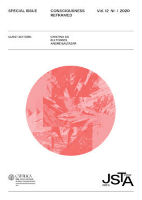
Journal of Science and Technology of the Arts
Scope & Guideline
Innovating the Intersection of Creativity and Technology.
Introduction
Aims and Scopes
- Interdisciplinary Approaches to Art and Technology:
The journal emphasizes the integration of various disciplines, including visual arts, performance, digital media, and technology, highlighting how these fields inform and enrich each other. - Critical Theory and Aesthetic Inquiry:
A strong focus on critical theory allows for in-depth analyses of artistic practices, exploring themes such as representation, identity, and the socio-political dimensions of art. - Community Engagement and Co-Creation:
The journal features studies on collaborative artistic practices that involve community participation, emphasizing the role of art in social change and collective experiences. - Exploration of New Media and Interactive Art:
A key area of focus is the role of new media, including virtual reality, digital art, and gaming, in shaping contemporary artistic narratives and audience experiences. - Feminist and Intersectional Perspectives:
The journal consistently addresses issues of gender, identity, and intersectionality in the arts, promoting discussions around representation and inclusivity.
Trending and Emerging
- Gender and Identity Studies in Art:
There is an increasing focus on gender and identity, particularly feminist perspectives and intersectionality, reflecting broader societal conversations about representation and equity in the arts. - Technology-Driven Artistic Practices:
The journal highlights the growing influence of technology in artistic creation, with discussions on artificial intelligence, virtual reality, and interactive installations becoming more prevalent. - Empathy and Social Engagement in Gaming:
Recent studies explore the potential of gaming as a medium for empathy and social engagement, indicating a trend towards examining how interactive narratives can foster understanding and connection. - Critical Engagement with New Media:
There is a rising interest in the critical evaluation of new media forms, particularly in how they impact audience perception and artistic expression, signaling a shift towards contemporary media literacy. - Community-Centric Art Practices:
Emerging themes include community-centric art practices that emphasize co-creation and participatory approaches, reflecting a desire for art to engage with social issues and collective experiences.
Declining or Waning
- Traditional Art Criticism:
There has been a noticeable decrease in papers focused on traditional art criticism, indicating a shift towards more experiential and participatory forms of critique that emphasize audience engagement. - Historical Analysis of Artistic Movements:
Fewer articles are dedicated to historical analyses of past artistic movements, suggesting a move away from retrospective studies towards contemporary practices and their immediate socio-cultural contexts. - Static Representations of Art:
The journal has moved away from discussions centered on static or singular interpretations of artworks, favoring dynamic and interactive experiences that engage with technology and community.
Similar Journals

CONNAISSANCE DES ARTS
Fostering Scholarly Engagement with the ArtsCONNAISSANCE DES ARTS, published by SFPA-CONNAISSANCE ARTS, is a prominent French journal that has been enriching the landscape of Visual Arts and Performing Arts since its inception in 1969. With an ISSN of 0293-9274, this journal offers a platform for critical exploration and scholarly discourse, making notable contributions especially in the realms of art history, criticism, and contemporary artistic practices. Although the journal currently holds a Q4 quartile ranking in its category and ranks in the lower echelon of Scopus ranks (#638 out of 667), its focus on niche topics within the arts makes it a valuable resource for researchers and professionals who seek to engage with less mainstream topics that often go overlooked. The journal publishes insightful articles, reviews, and essays, contributing to the nurturing of artistry and culture in France and beyond. While it is not an open-access publication, the journal remains a significant entity for academics and practitioners keen on advancing their understanding of visual and performing arts. For further engagement with the journal, interested parties can reach out or submit inquiries to its address at 51 RUE VIVIENNE, 75095 PARIS CEDEX 02, FRANCE.
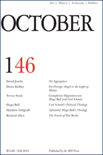
OCTOBER
Illuminating the Convergence of Literature, Music, and ArtOCTOBER is a seminal journal published by MIT PRESS that spans a diverse array of interdisciplinary themes within the humanities, specifically focusing on literature and literary theory, music, and the visual arts and performing arts. Established in 2002, this journal has become a cornerstone for scholars and practitioners seeking critical discourse and innovative research across its converged fields, maintaining a respectable impact factor that attests to its influence in academic circles. While OCTOBER currently does not offer open access, it provides valuable insights and analysis that drive contemporary thought and discussion, positioned in the Q2 and Q3 quartiles of Scopus rankings. The journal’s commitment to high-quality scholarship makes it an essential resource for those looking to deepen their understanding of cultural and artistic practices, reflecting the evolving landscape of the arts and humanities from a rigorously theoretical perspective.
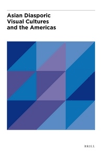
Asian Diasporic Visual Cultures and the Americas
Unveiling the Complexities of Diasporic Visual ExpressionAsian Diasporic Visual Cultures and the Americas is a pioneering journal published by BRILL, dedicated to exploring the intersections of visual culture, identity, and diaspora within the context of the Americas. With an ISSN of 2352-3077 and E-ISSN of 2352-3085, this journal has established itself as a significant resource for academics, researchers, and students interested in the visual arts and their broader social implications. Since its inception in 2015, the journal has been committed to fostering interdisciplinary dialogue, providing a platform for innovative research that examines how Asian diasporic communities express their identities through visual mediums. Despite its relatively recent establishment, it endeavors to challenge and expand the narratives related to visual arts in a diverse and globalized world. Though the journal currently does not offer open access options, it remains a vital asset for those engaged in understanding the critical dynamics of race, ethnicity, and culture in contemporary visual practices. Converging insights from both the arts and social sciences, this journal invites contributions that illuminate the complexities of diasporic experiences, making it a pertinent choice for those aiming to contribute to this evolving field.

Religion and the Arts
Connecting Spiritual Narratives with Creative EndeavorsReligion and the Arts is a distinguished scholarly journal published by BRILL, based in the Netherlands, with a dedicated focus on the interdisciplinary exploration of religion and its interplay with various artistic expressions from historical and contemporary perspectives. Established in 1996, this journal serves as a vital platform for researchers, professionals, and students interested in Cultural Studies, History, Religious Studies, and the Visual and Performing Arts. Despite its current classification in the Q4 category across multiple fields, it remains committed to advancing academic discourse and fostering innovative approaches to understanding the complex relationships between spirituality and artistic creation. With its ISSN 1079-9265 and E-ISSN 1568-5292, the journal invites submissions that contribute to enriching this dynamic field, ensuring that a diverse range of voices and perspectives are represented. Although not an Open Access publication, the journal’s content continues to be pivotal for scholarly engagement and is essential reading for those dedicated to the study of art's profound connections with religious traditions.

Quintana-Revista do Departamento de Historia da Arte
Illuminating the Intersection of Art History and Cultural HeritageQuintana-Revista do Departamento de Historia da Arte, published by the Universidade de Santiago de Compostela, is a distinguished academic journal that focuses on the critical analysis and exploration of visual arts and performing arts. With its ISSN 1579-7414 and E-ISSN 2340-0005, this journal serves as a vital platform for researchers, professionals, and students interested in the depth of art history and cultural discourse. Operating under a Q4 category in the realm of Visual Arts and Performing Arts, the journal is committed to fostering scholarly dialogue and advancing knowledge in the field. Though it currently does not offer open access options, it remains an invaluable resource for those aiming to contribute to and understand the evolving landscape of art history. The journal covers converged years from 2011 to 2012 and 2014 to 2024, highlighting its ongoing relevance and adaptability to contemporary discussions. As it continues to enhance its visibility and impact within the 20th percentile of its category according to Scopus rankings, Quintana invites contributions that deepen our understanding of artistic expression and cultural heritage.

GOYA
Exploring Contemporary Trends in Visual and Performing ArtsGOYA, published by the esteemed FUNDACION LAZARO GALDIANO, is a pivotal journal in the field of Visual Arts and Performing Arts. With an ISSN of 0017-2715, this Spanish journal serves as a critical platform for scholars, artists, and practitioners to engage with contemporary issues, trends, and methodologies in the arts. Since its inception, GOYA has strived to illuminate the intersection of artistic expression and cultural discourse, with coverage spanning from 2002 to 2024. The journal proudly holds a Q3 category ranking in the 2023 Scopus assessments for its field, reflecting its respected position among peers, with a notable rank of #377 out of 667. Though it does not follow an Open Access model, GOYA continues to contribute significantly to the academic landscape, enabling a deeper understanding of artistic practices and their societal implications. Researchers and students alike will find the journal an invaluable resource for insights and inspiration within the dynamic realm of the arts.
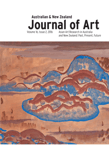
Australian and New Zealand Journal of Art
Celebrating Diverse Artistic MethodologiesThe Australian and New Zealand Journal of Art, published by Taylor & Francis Ltd, stands as a critical platform for scholarly discourse in the fields of art, visual arts, and performing arts, contributing to the ongoing dialogue regarding contemporary artistic practices and methodologies across Australia and New Zealand. With an ISSN of 1443-4318 and an E-ISSN of 2203-1871, this journal invites submissions that strive for innovation and insightful critique, aiming to foster a deeper appreciation and understanding of diverse artistic expressions. Despite its classification in the fourth quartile under the Arts and Humanities categories, it continues to attract attention within its niche, as evidenced by its Scopus rankings, indicating its vital role in the academic landscape. The journal is committed to bridging the gap between research and practice, providing access to a wealth of interdisciplinary knowledge for researchers, professionals, and students alike.

Arte Individuo y Sociedad
Connecting Scholars and Practitioners through Artful Discourse.Arte Individuo y Sociedad, published by UNIV COMPLUTENSE MADRID, SERVICIO PUBLICACIONES, is a leading Open Access journal dedicated to advancing understanding in the realms of Visual Arts and Performing Arts. With an impressive impact factor that places it in the Q1 category of its field and a remarkable Scopus rank of #92 out of 667, this journal stands as a vital resource for scholars, practitioners, and students alike. Since its inception in 1988, the journal has championed the dissemination of innovative research and critical discourse, fostering a platform where creativity and academia intersect. The converged years from 2010 to 2024 signify a dynamic evolution of the journal, reflecting contemporary issues and developments in visual and performing arts. For those interested in exploring the complex interplay between art and society, Arte Individuo y Sociedad offers essential insights and diverse perspectives in an increasingly interconnected global landscape.
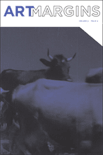
ARTMargins
Challenging narratives through critical dialogue.ARTMargins, published by MIT Press, stands at the intersection of cultural studies, history, and the visual and performing arts. Since its inception in 2012, this journal has provided a platform for critical dialogue and scholarly inquiry into contemporary art and its socio-political contexts, exploring the margins of artistic practice and representation. With a current Q3 ranking in Cultural Studies and History, and a Q2 ranking in Visual Arts and Performing Arts, ARTMargins is recognized for its impactful contributions to its fields, despite facing significant competition. The journal caters to academics, professionals, and students eager to delve into nuanced analyses and interdisciplinary approaches that challenge traditional narratives. As an essential resource for those studying art's role in society, ARTMargins fosters a deeper understanding of how culture shapes and is shaped by ephemeral artistic expressions. While the journal operates under a subscription model, it remains committed to accessibility and wide-reaching discourse within the academic community.
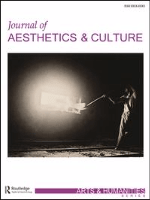
Journal of Aesthetics & Culture
Fostering Dialogue Between Culture and PhilosophyJournal of Aesthetics & Culture, published by TAYLOR & FRANCIS LTD, is a prestigious Open Access journal that has been serving the academic community since its inception in 2009. Based in the United Kingdom, this journal aims to explore, document, and critically engage with themes in Cultural Studies, Philosophy, and the Visual and Performing Arts. Notable for its impact, the journal holds a Q3 ranking in Cultural Studies and Philosophy, and a Q2 ranking in Visual Arts and Performing Arts as of 2023. With its Scopus rankings placing it within the top 17% of Visual Arts and Performing Arts journals and top 31% in Philosophy, it stands as a vital resource for researchers and practitioners alike. Covering a broad range of contemporary issues and inviting innovative perspectives, the Journal of Aesthetics & Culture plays a crucial role in shaping critical discourse within its fields and fostering an understanding of the intricate interplay between aesthetics and societal contexts.